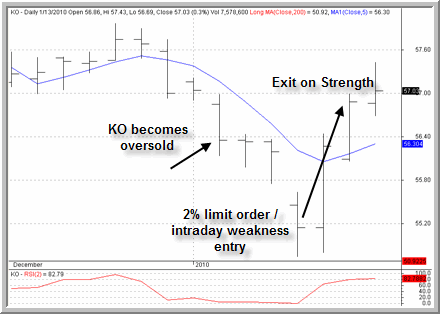Intraday Weakness and Scaling-In: Two Greatest Secrets of High Probability Trading
When it comes to high probability trading, the idea of buying weakness and selling strength is paramount. High probability trading in general – and both Stock and ETF PowerRatings trading in specific – are a mean reversion based set of strategies that allow traders to take advantage of time-tested (and quantified) tendencies in both stocks and exchange-traded funds.
But what makes high probability trading so worthwhile for so many traders is that we take the idea of buying weakness an additional, critical step further, by looking to buy markets not WHEN they become oversold, but after they become EVEN MORE oversold.
In stocks, this technique is called “intraday weakness”. In exchange-traded funds, this technique is called “scaling-in.” But both high probability trading tactics are based on the same fundamental premise: the more oversold the market, the more interested the high probability trader should be in that market.
As you will see in the below examples – one with a stock and one with an exchange-traded fund – a market becoming oversold is a prerequisite for high probability trading, but it is not sufficient – alone – for a trade. By waiting for those markets to become even more oversold – either on an intraday basis in the case of stocks or with subsequent lower closes in the case of ETFs – high probability traders are able to maximize the process of “buying the selling.”
For our intraday weakness example, let’s take a look at ^KO^. Here, all we are looking to do is identify the oversold stock (a close with the 2-period RSI of less than 10). This happened in KO on the close of January 5th at 56.35.

We will set intraday weakness at 2%. This means a trader would place a limit order 2% below the oversold closing price (56.35 above). Intraday weakness targets can be as aggressive as 2% below the oversold closing price or as conservative as 6 or even 8% below the oversold closing price. More aggressive approaches will produce more trades. More conservative approaches will produce greater accuracy.
With a limit order at 55.22, KO hit this price level intraday on January 8.
As you can see from the progress of KO afterwards, this intraday weakness strategy would have helped traders buy shares of KO at a very low level. Two days later, KO was up 3%.
Scaling-in allows traders to do something very similar, only with exchange-traded funds. We’ll take a look at how scaling-in works for high probability ETF traders in next week’s column. For now, start looking at oversold stocks and seeing the kind of low-priced entries that are possible using various intraday weakness entries from 2-6% or so.
Learn new strategies for the New Year, including never-before seen short term ETF trading strategies in Larry Connors’ bestseller, High Probability ETF Trading. Recently Awarded the Top 10 Trading and Investing Book of 2009 by Stocks, Futures, and Options Magazine, High Probability ETF Trading has just been released in paperback for the first time ever. Click here to order your copy today.
David Penn is Editor in Chief at TradingMarkets.com.
